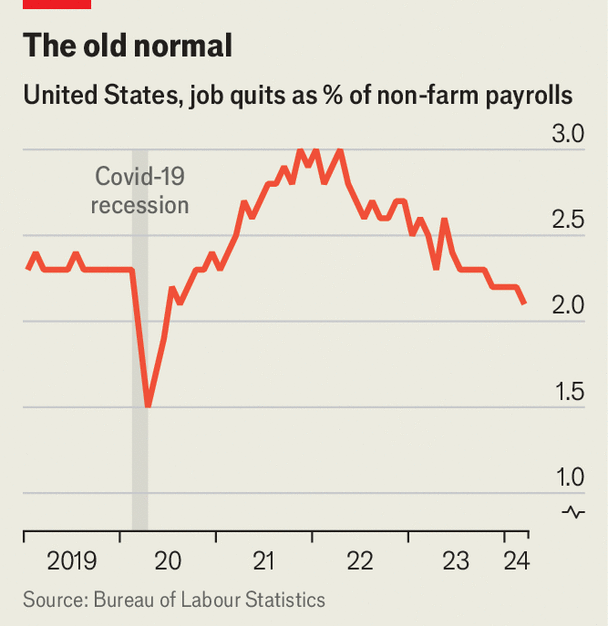Competition has cooled—for now

Two years ago companies in America were scrambling to plug vacancies from shop floors and call centres to corporate headquarters. Workers laid off during the pandemic proved difficult to lure back, particularly those that had opted for early retirement. Others who spent their lockdowns dreaming of new beginnings resigned en masse once business resumed as normal. The share of American workers quitting their jobs each month went from 2.3% before the pandemic to a record 3% at the start of 2022. By March of that year there were two job openings for every unemployed worker in America.

That frenzy has now passed. As economic growth has slowed, employers have reined in hiring. On May 3rd the Bureau of Labour Statistics reported that America added 175,000 jobs in April, well below expectations. Companies including Nike, a sportswear brand, and Tesla, a maker of electric vehicles, have announced lay-offs in recent weeks. The ratio of job openings to unemployed workers has dwindled to 1.3. With quit rates down to 2.1%, the “great resignation” appears to have fizzled out (see chart).
Workers sense that their power is waning. The number of active strikes in America fell from a post-pandemic high of 76 in September to 40 in March, according to a tracker compiled by researchers from Cornell University and the University of Illinois. The share of work that employees do at home has hovered between 25% and 30% since the start of last year, less than they say they would like. Companies, meanwhile, are cracking down on unruliness. Google, a technology giant, sacked around 50 employees last month for protesting over a cloud-computing deal with Israel’s government.
For bosses, though, the war for talent is not entirely over. Fully 70% of American companies surveyed earlier this year by ManpowerGroup, a staffing firm, said they were having difficulty filling roles. That is down from 75% last year, but up from 40% a decade ago. Johnny Taylor junior, head of the Society for Human Resources Management, a business association, says that the job market has shaken off the “unsustainable craziness” of recent years, but is expected to remain tight.
One reason is demography. The World Bank forecasts that over the course of the 2020s the share of America’s population aged between 20 and 64 will fall from 59% to 56%. A second reason is the growing mismatch between the skills employees have and the ones employers need as the economy continues to digitise. The emergence of generative artificial intelligence has heightened that concern, says Anu Madgavkar of McKinsey, a consultancy.
Despite all their talk of retraining workers for the digital age, companies are dragging their feet. Average training budgets among American firms with over 10,000 employees fell from $19m in 2022 to $16m last year, according to Training, a trade publication. Such costs are often among the first to be trimmed when business slows. Once it picks up again, bosses may rue their skimpiness. ■
Excerpts: The economist




COMMENTS